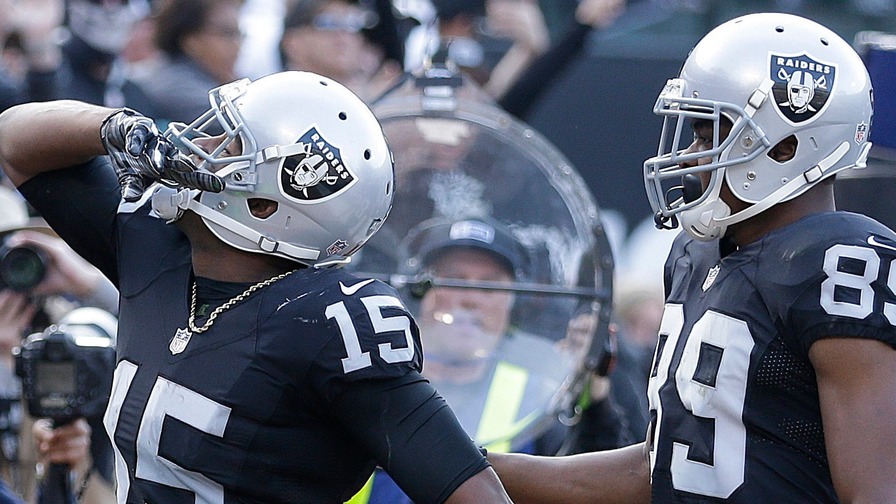Fantasy Football: Who Is the Oakland Raiders' Best Receiver?

Figuring out Amari Cooper and Michael Crabtree has been one of the more difficult chores in fantasy football for the past two years. The offense is on the rise with an up-and-coming passer in Derek Carr, but figuring out which wideout to invest in has been tough.
Per average draft position data (ADP) at Fantasy Football Calculator, the general opinion coming into 2016 was that Cooper was -- by far -- the better fantasy option. Cooper was drafted 23rd overall (12th wideout) compared to Crabtree's ADP of 93rd overall (38th receiver) in 2016 fantasy drafts. Crabtree was taken behind the likes of Sterling Shepard, John Brown, Tyler Lockett and even Josh Gordon.
So that was the general opinion prior to last season. How did things play out in 2016, and what does it mean moving forward?
What They've Done
Over the past two seasons, both Cooper and Crabtree have played in 16 games, so we've got an even sample size with which to work.
Here's what the duo did in 2015, Cooper's rookie year, with the fantasy totals from standard formats.
| Player | Amari Cooper | Michael Crabtree |
|---|---|---|
| Receptions | 72 | 85 |
| Yards | 1,070 | 922 |
| Touchdowns | 6 | 9 |
| Fantasy Points | 140.7 | 146.2 |
And here's what they did this past season.
| Player | Amari Cooper | Michael Crabtree |
|---|---|---|
| Receptions | 82 | 89 |
| Yards | 1,149 | 1,003 |
| Touchdowns | 5 | 8 |
| Fantasy Points | 148.9 | 150.3 |
Crabtree gets the edge in receptions, touchdowns and fantasy points in both seasons, although Cooper was close. Crabtree has held a substantial edge as a red zone weapon, catching six more touchdowns than Cooper over the past two seasons. In that stretch, Crabtree has out-targeted Cooper, 41 to 25, in the all-important red zone.
Counting all 32 games, Cooper averages 9.0 fantasy points per game while having a standard deviation of 6.7. This means that 68% of the time, Cooper will score between 2.3 and 15.7 points. Crabtree averages 9.2 points per game and has a standard deviation of 6.01. Meaning that 68% of the time, Crabtree will score between 3.7 and 15.2 points. This gives Crabtree the slight edge in consistency, and we already know his touchdown upside as been higher.
What Our Metrics Say
Using our Reception Net Expected Points (NEP) metric, we find that during the 2016 season, Crabtree finished eighth in the NFL with 96.25 Reception NEP, a cumulative statistic, while Cooper's Reception NEP of 88.98 ranked 16th.
On a per-target basis, neither player was very efficient, with each checking in outside of the top 30 wideouts in Reception NEP per target among receivers with at least 80 targets. Cooper finished 33rd with 0.67 Reception NEP per target, and Crabtree was just behind him in 37th with 0.66 Reception NEP per target.
Underappreciated
Even though Crabtree has outscored Cooper over the past two seasons, Cooper was drafted 70 picks ahead of him in 2016 drafts. Cooper was also selected to his second Pro Bowl this year, while Crabtree was left off the roster.
When trying to explain the gap in ADP, we can probably look to age. Cooper is 22, seven years younger than Crabtree. The allure of hitting on a breakout player may be enticing fantasy owners to take Cooper too early while Crabtree, the mundane veteran, isn't an exciting pick.
The Market Is Correcting
It's obviously still very early to put too much stock into 2017 ADP numbers, but the fantasy community seems to be figuring this one out. Looking at early draft results for 2017, again using Fantasy Football Calculator, Cooper is currently coming off the board 38th overall while Crabtree is 45th. Among wideouts, Cooper is WR15, and Crabtree is WR20.
Compared to 2016 ADP, Cooper's stock has fallen back over a full round while Crabtree's ADP -- he was 93rd overall last year -- has been cut in half.
In fantasy, when it comes to getting a player, everything is relative to price. Cooper's and Crabtree's ADP was out of whack prior to last season, and while it's starting to correct itself, Crabtree is still the better buy going by the numbers. With that said, it's a lot easier to feel good about selecting Cooper at this current price as opposed to last year's ADP, and if he can get more involved in the red zone, he could be the Raiders' top receiver in 2017.
















